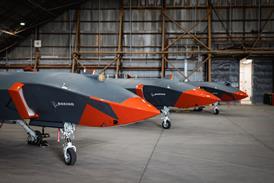Michael Whitaker, head of the Federal Aviation Administration, admitted to US lawmakers on 13 June that the agency should have been more proactive in overseeing Boeing’s factories prior to the Alaska Airlines flight 1282 incident.
Appearing before the US Senate Committee on Commerce, Science and Transportation, Whitaker discloses that the FAA has “multiple active investigations into Boeing”, some of which are based on whistleblower tips.
”Let me also acknowledge the FAA should have had much better visibility into what was happening at Boeing before 5 January,” he says. “The FAA’s approach was too hands-off, too focused on paperwork audits, and not focused enough on inspections.”
“We have changed that approach over the last several months and those changes are permanent,” he adds.

Whitaker’s testimony focused on the FAA’s increased oversight of Boeing since flight 1282 on 5 January. That incident, which rocked the airline industry, involved a door-plug blowing out of an Alaska 737 Max 9 during a flight.
An ensuing investigation revealed that Boeing workers removed the Alaska jet’s door-plug during the assembly process to allow workers from fuselage supplier Spirit AeroSystems to address a riveting issue. Boeing employees replaced the plug but apparently failed to bolt it back in place.
Since the beginning of January, the US airframer has significantly slowed production as it grapples with outstanding quality and safety problems, with 737 production capped by the FAA at 38 aircraft monthly – but Boeing’s actually production being much lower.
Boeing recently presented the FAA with a “roadmap for continuous improvement” detailing how it plans to remedy its ailing production lines.
The plan addresses findings from the FAA’s audits and recommendations from an FAA-convened review panel, in addition to feedback from Boeing employees, and covers increased workforce training, simplifying production processes, eliminating defects and shoring up the safety culture.
“Many of these actions are underway, and our team is committed to executing on each element of the plan,” David Calhoun, Boeing’s chief executive, said in late May. “It is through this continuous learning and improvement process that our industry has made commercial aviation the safest mode of transportation. The actions we are taking today will further strengthen that foundation.”
Maria Cantwell, a senator from Washington state who chairs the committee, pressed Whitaker during the 13 June hearing, asking if Boeing’s safety culture is shifting in a positive direction.
“The question is, what can you do to change this culture? You were overwhelmingly confirmed to be the agent in charge of the FAA. You had an overwhelming vote in the United States Senate. So, we’re counting on you to be that agent of change. We know that this begins with taking a hard look a the agency itself.”

Whitaker, confirmed by Congress in October 2023, acknowledges FAA shortcomings.
“We have now moved to a more-active, comprehensive oversight model – the audit-plus-inspection approach – which allows the FAA to have much better insight into Boeing’s operations,” he says. “I will personally remain engaged to ensure that Boeing executes the necessary changes to transform its culture and address its production quality issues.”
Cantwell points to the FAA-convened panel’s review, which found a “disconnect” between senior leadership and factory workers, as an area of specific concern.
“The safety management systems have to have a culture where employees are free to speak up, identify risks and have those risks taken seriously,” Whitaker responds. ”It allows you to find risks that might not be obvious, and one way you get that is by hearing from your employees who are on the front lines.”
Senator Ted Cruz of Texas focused on the lack of documentation regarding the 737 Max 9 that operated as Alaska flight 1282 on 5 January. An investigation by the National Transportation Safety Board revealed earlier this year that no paperwork related to the door-plug exists, and security camera footage was apparently overwritten.
“Boeing doesn’t know who performed work on the door-plug and no paperwork exists – is that right?” he asks.
“That is my understanding,” Whitaker responds.
“That seems remarkable and shocking,” Cruz says. “Is there concern at the FAA that an employee at Boeing is hiding key information about this?”
Both the FAA and the US Department of Justice are investigating the matter, Whitaker says, adding that it is “too early to have an opinion on that”.
Pledging to personally meet with Boeing’s senior leaders on at least a quarterly basis, Whitaker says there is no timeline for lifting the production cap on Boeing’s 737 programme, as the FAA’s discussions with the company remain focused on safety metrics.

















































